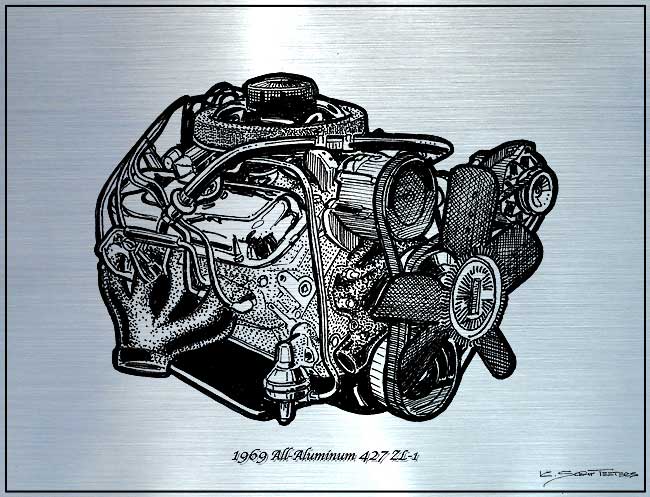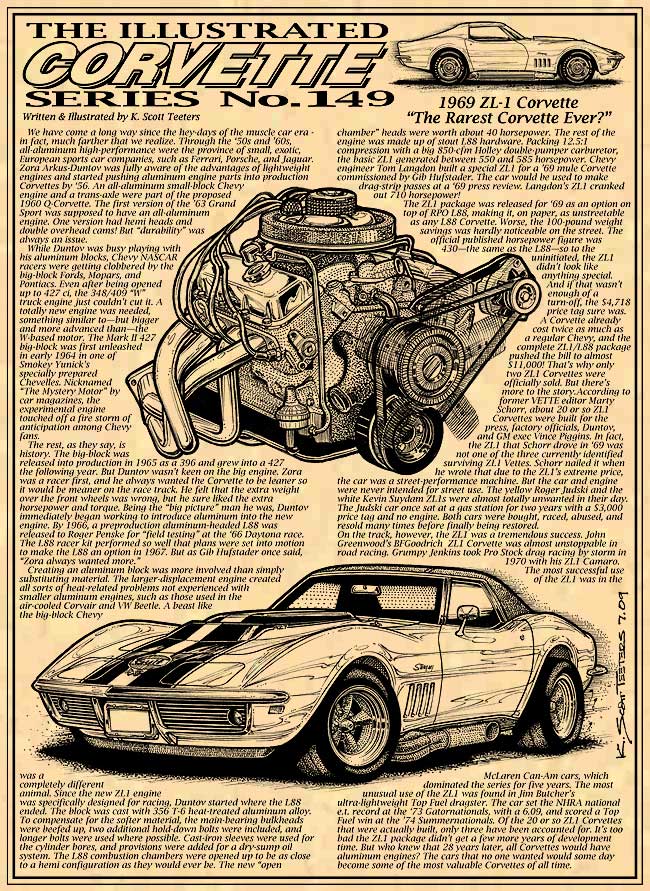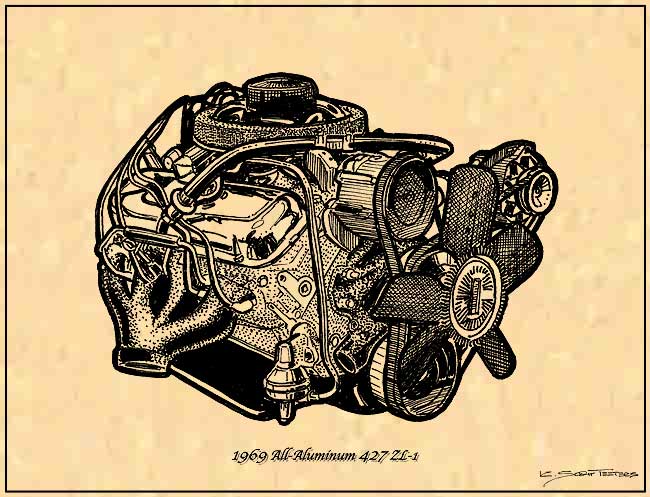Dateline: 8.29.12
Thanks to Kevin Mackay and his team at Corvette Repair, once piece of lost Corvette history has been found, refurbished, and ready for the show circuit.
Be sure to catch the below slide show!
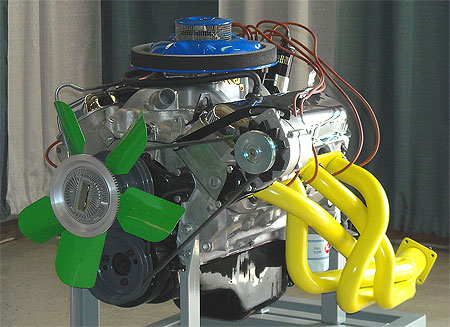
The entire Q-Chevrolet project quickly fizzled due to cost concerns but several great ideas came out of the project. The unique Peter Brock and Bob Veryzer-designed body eventually was developed into the 1963 Sting Ray. The all-aluminum engine proposal started the ball rolling with aluminum parts gradually seeded into various Corvette engines. While aluminum water pumps, intake manifolds, and bell housings were relatively easy to develop, heads and the block were another story. By the early ‘60s, Duntov began experimenting with aluminum heads, but they proved to be unreliable. The small-block Chevy engine was already a lightweight, but the thought of an even lighter version of the engine was indeed tantalizing.
Corvettes have been powered by all-aluminum engines since the arrival of the LS1 in the all-new C5 1997 Corvette. Of course, today nearly all engines are made with the lightweight metal. These days, the move is on to integrate even lighter magnesium, carbon fiber, and plastic parts wherever possible. But back in 1957, only the exotic cows of the most expensive European sports cars had all-aluminum engines.So in 1957 when new general manager Ed Cole proposed his Q-Chevrolet line of trans-axle cars, including the Corvette, Zora Arkus-Duntov jumped on the chance. No one inside GM was more tuned into the advantage of an all-aluminum engine than Duntov. The proposal Duntov outlined for his vision of the Q-Corvette included the mandatory trans-axle and an all-aluminum, fuel-injected small-block Chevy engine. The Rochester Fuelie had just arrived and the small-block Chevy engine was only in its third year of production. No one in Detroit was making all-aluminum engines, so this was a very outrageous proposal.
[nggallery id=73]
It wasn’t until after the all-new Mark IV 396 big-block came out in ‘65 did work begin on the aluminum head L88 engine. Duntov always made the best of a given situation. For instance, he was not a big fan of the Sting Ray body design and had several very heated battles with VP of Design, Bill Mitchell, but it didn’t stop him from pushing for the lightweight Grand Sport. Zora also wasn’t in favor of using the larger, heavier big-block engine for the Corvette. On paper, one can argue that its a bad idea for a sports car, but I’m sure that after a few laps in the prototype 396, he changed his mind. But there’s always that extra weight in the front of the car that really bugged Zora.
Being the fox he was, I’m sure after his first lap in a big-block he was thinking, “Aluminum baby, aluminum!” After a few minutes with a slide ruler, the thought of big-block power and torque coming from an engine weighing as much as a small-block was indeed juicy and still is! The introduction of the L88 in ‘67 was most likely in Zora’s mind an interim step and Duntov certainly wasn’t the only one imagining the potential.
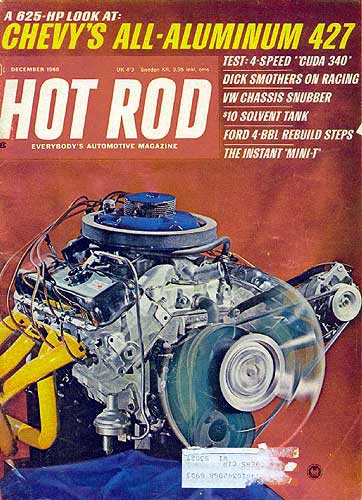
So when the December 1968 issue of Hot Rod Magazine hit the news stand with a race-ready, all-aluminum 427 looking like it was about to zoom off the cover, HEADS SPUN! Hot Rod caught some heat from readers for their artistic indulgence with the spinning fan, but the bright yellow tube headers and exotic-looking L88 air cleaner became an instant legend.
Then came the bad news – THE PRICE! The base price of a ‘69 Corvette was $4,781 and the ZL-1 option was a staggering $4,718 – just $70 less than the cost of the entire base car! Needless to say, there were only two takers and the engine quickly was elevated to legend status. However, more than two ZL-1 Corvette were indeed built – one yellow car with unique black strips and an orange roadster. CARS Magazine editor Marty Schorr test drove a press car that was blue and gave the package an unfavorable review. And why wouldn’t he? After all, the ZL-1 was the same as an L88 package, which was NOT designed for the street – PERIOD! It was a racing package.
So, for a street Corvette, the Zl-1 offered a slight weight reduction that unless you were on a track you wouldn’t notice, plus the car was as unstreetable as any regular L88 Corvette. All that for double the cost of a Corvette. And what became of the ZL-1’s prepared for the press, such as the car Schorr drove? They were most likely stripped of their good parts, with the remains sent to the crusher.
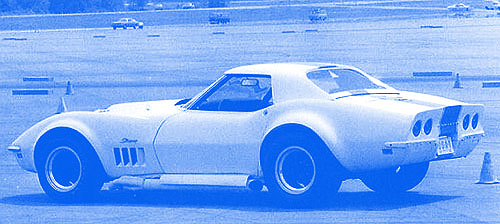
But the automotive press and Duntov had a field day with the engine. Duntov stoked the press with one of his mule Zl-1 Corvettes, outfitted in full road racing regalia – fat racing tires on racing mag wheels, big L88 fender flares, white header side pipes, L88 hood, and the full L88 suspension treatment. The only things missing were sponsor decals and a racing number. But the main star was the all-aluminum 427 engine. Tech writer Roger Huntington wrote, “Get out your pocket magnets fellows, this engine is all aluminum.”
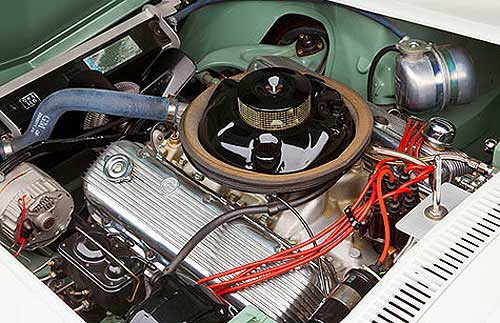
It was all very heady, fun stuff, and in retrospect, a delightful way to begin the close of the muscle car era. But least you think that only two ZL-1 427 ever saw the light of day or any racing action – no, no! Grumpy Jenkins dropped a ZL-1 into his ‘69 Pro Stock Camaro and shook up the troops. The McLarren Can-Am road racers just mopped up the competition for a few years with the ZL-1 engine. John Greenwood psyched out the competition at Le Mans with rumors that his Zl-1 Corvette was making 800-horsepower! Then in 1973 Top Fuel drag racer Jim Butcher blew everyone’s minds by breaking the NHRA Top Fuel ET record with his ZL-1-powered rear-engine dragster. Thanks to the Chevrolet Parts Department, if you had the bucks, a Zl-1 could be yours.
But as the ‘70s moved on and it became obvious that performance cars were all but dead, the ZL-1 faded into the past. And a few years after the debut of the all-aluminum LS1 for the production C5 Corvette, the ZL-1 was largely forgotten, except for ZL-1 geeks like yours truly and L88 man, Kevin Mackay. Kevin has carved a unique nitch for himself by specializing not only in C1, C2, and C3 Corvette restorations, but also the restoration of early Corvette race cars. Mackay and his team of experts at Corvette Repair had had the honor of having their hands on some of the most unique early Corvettes. Mackay has a knack for researching VIN numbers, as well as casting numbers. In early 2012 he located the R&D ZL-1 engine that was used on the cover of the December 1968 issue of Hot Rod Magazine, as well as the H.P. Books “How to Hot Rod Big-block Chevy 396, 404, 427 454.”
When Kevin told me about his find, he said that like his other restoration work, his intention was to refurbish the ZL-1 back to its Hot Rod cover girl configuration in time for the 2012 30th Corvettes at Carlisle Show. If you have never been to the Corvettes at Carlisle Show, every year, there’s a special feature called “Chip’s Choice” along the long wall of Building T. For 2012 the Chips Choice theme was “The Best of the Big-Blocks” and featured many of Corvette Repair’s magnificent big-block Corvettes. So it was very fitting that Mackay’s fully restored ZL-1 engine was part of the show.
Attending the Corvettes at Carlisle Show is a real pleasure. How often does a Corvette fan get to experience complete sensory overload. With 60 years of history and heritage, plus thousands of Corvettes in all different configurations, “sensory overload” about says it all. After several hours, it’s “Oh, there’s another Grand Sport, and another race car, and another stocker, and another…” So when I was in Building T looking at the ZL-1 engine on display, it was kind of surreal.
For me, it was a real thrill to see a piece of Corvette history that I had only ever seen in photographs for 43 years! Inside my head I was hearing, “WOW!!! There it is! The Hot Rod cover engine that started the legend!” By the time you are my age, most of the people at these shows are much younger and many weren’t even born when the big-blocks ruled the world of Corvettes. So while I was marveling at the sight of a unique piece of Corvette history that was once lost for a long time and now found and brought back to its former glory, others were just strolling by, glancing at the ZL-1, and moving on. Just an engine on a stand. – Scott
Related: The Great 454 ZL-1 1969 10-Second Monster Corvette Pumpkin! – CLICK HERE.
VIDEO – 427 ZL-1 John Greenwood & A NHRA Top Fuel Record Holder Chevy Top Fueler! – CLICK HERE.
The above 11×17 laser-etched print is available for just $49.95 + $8.00 S&H. Each print is signed and numbered by the artist. You can order your with the secure PayPal button below, or by calling 1-800-858-6670, Monday through Saturday 10AM to 9PM Eastern Standard Time.
The above 11×17 parchment print is available for just $24.95 + $6.95 S&H. Each print is signed and numbered by the artist. You can order your with the secure PayPal button below, or by calling 1-800-858-6670, Monday through Saturday 10AM to 9PM Eastern Standard Time.
The above 11×17 parchment print is available for just $24.95 + $6.95 S&H. Each print is signed and numbered by the artist. You can order your with the secure PayPal button below, or by calling 1-800-858-6670, Monday through Saturday 10AM to 9PM Eastern Standard Time.
Here’s the BEST way to keep up with K. Scott Teeters’ Corvette blog!



